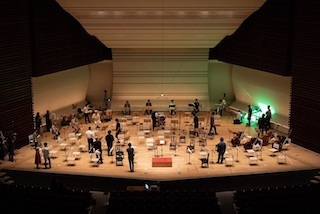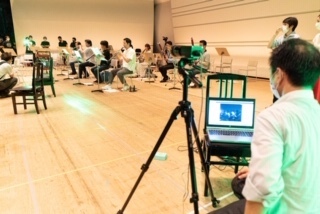Reshaping the concert stage
What will the orchestral concert stage look like post-Covid? Kazushi Ono recently led scientific tests with Tokyo Metropolitan Symphony Orchestra in the Bunka Kaikan Hall to determine a safe and musically viable distance between players. He shares the research
On 11 and 12 June, the players of Tokyo Metropolitan Symphony Orchestra and I took part in trials in the Tokyo Bunka Kaikan Hall, in cooperation with Keio University and Saint Marianna School of Medicine. Our goal was to find the delicate balance between creating sanitary conditions and making music, and to explore the possibilities of orchestral playing post-Covid, while reassuring the musicians.
The critical situation for Coronavirus peaked earlier in Europe than in Japan so we had been able to gather guidance from the European orchestras that had restarted, as well as scientific and medical institutions. However, I spoke to several Japanese medical advisers and decided to hold experiments specific to Japanese orchestras and halls, because there have been different infection and mortality patterns in Japan that might be specific to our situation – our custom of wearing masks and the humidity in Japan.
European trials have recommended distances of 1.5m and 2m (including studies by Freiburg University in cooperation with Bamberg Symphony Orchestra and Berlin’s Charité Medical University with seven Berlin orchestras). We started with 2m between musicians, each with their own stand. This meant that only one person from each section could be at the front, as there wasn’t enough space for two people on the front desk. The number of players in each section was 8–7–6–5–2: a total of 29. With 2m distancing, they were spread far apart and filled the stage, so there was no room for any more – either strings or winds. We also kept 2m between the conductor and front desks, and there was an acrylic board between us.
‘It was clear that 2m is difficult to accept from the point of view of musical quality’
On the first day we were strings only, with a programme of the Prelude and Air from Grieg’s Holberg Suite and Tchaikovsky’s Serenade for Strings (first and fourth movements). I chose the Holberg Suite because the score includes many divisi, so it’s a good test of how divided parts sound and how the musicians can play together when they’re so far apart. They couldn’t hear each other very well and the players on the back desks couldn’t see the conductor properly. It was clear that 2m is difficult to accept from the point of view of musical quality.
Taking account of these results, our medical adviser, Dr Kawase from Saint Marianna School of Medicine, proposed that we take closer positions, under the presumption that non-speaking string musicians wearing masks are not at danger of infection. So, we tried 1.5m, which meant that there was space for more musicians to join us on stage – the formation was 10–9–8–6–4, with a total of 37 players.
We played the Air from the Holberg Suite. Although there were more players and they were closer, the sound was still thin in a large hall, which has a capacity of 2,000. The divisi first-violin lines didn’t sound homogenous and the harmonies of the lower parts seemed separate, and not a proper basis for the whole structure.
We then tried the first movement of Tchaikovsky’s Serenade with a distance of 1m. The Vienna Philharmonic Orchestra players were even closer when they restarted their concert at the end of May, keeping an 80cm distance, and according to their scientific tests, the distance travelled by breath droplets from wind players was far smaller than they had estimated: spray from the flute, which might seem to be the strongest, was around 75cm. That allowed us to feel safe trying 1m.
This test gave us very different results from the previous one. The musicians were positive that they could hear each other easily, and the players on the back desk could see the conductor clearly. Playing Tchaikovsky gave the musicians great joy and we ended the first day feeling positive – it was a good choice.
For the second day, we invited Professor Tomoaki Okuda, a specialist in Aerosol Engineering at Keio University, to measure the aerosol (spray) released by the winds. We also brought in Dr Hiroyuki Kunishima, from the Department of Infectious Diseases at St Marianna University, to give his opinion about the adequate distance between the strings, winds and percussion, from the point of view of the risk of infection.
The aerosol was measured for trumpet, trombone, horn, tuba, flute, piccolo, oboe, bassoon, clarinet, bass clarinet, man’s voice (bass) and woman’s voice (soprano). It was clear that the greatest aerosol came from the bass voice, although the intensity and speed depended on the style of singing. For example, the vocal line from Beethoven’s Ninth Symphony (‘O Freunde, nicht diese Töne!) created less aerosol than Italian songs, which had many bursts on the consonants.
The male singer was was 190cm tall and when he stood 65cm from the measuring instrument, it clearly registered the aerosol. When he stood 180cm away from it, the reading was much smaller. The splash for the female singer was less.
‘The wind instrument tests showed that players make less spray during a concert than they do in daily conversations before and after the concerts and in daily life’
When Professor Okuda measured the aerosol of the wind instrument players, there was a strong result when the measuring instrument was close to their mouths, but it was less than that of the male singer. The wind instrument tests showed that players make less spray during a concert than they do in daily conversations before and after the concerts and in daily life.
After this test the brass instruments played the Fanfare from Dukas’s La Péri with the 1.5m distance, and a very big gap between the fourth horn on the left side and tuba on the right side – almost 8m from right to left. They couldn’t see each other well and were not able to play together, even though they knew the piece well and the first trumpet gave clear signs. We positioned them slightly closer, which was clearly better, but it was still difficult to blend the sound and be exactly together. Finally, they were positioned at 1m and adjusted themselves superbly.
Next, the winds played the first movement of Brahms’s First Symphony at the 1.5m distance. Since they are positioned more centrally than the brass, the ensemble was not bad, but the sound could not blend well, and you could only hear particular instruments separately. This was also resolved with 1m – the musicians were accustomed to finding their way naturally at this distance.
‘It’s especially important that string players can feel the winds behind them, but at a distance that reassures them of their safety’
The string section then joined us. This was the key step for the experiment: to create a proper distance between the string, wind and brass sections. It’s especially important that string players can feel the winds behind them, but at a distance that reassures them of their safety.
We started Mozart’s Overture to The Marriage of Figaro with a distance between the back desk of strings and the first row of winds of 1.5m, with desks of 12–11–8–7–4. The concertmaster whispered to me, ‘I can’t hear the bassoon.’ This was conclusive. The most essential thing about the beginning of Figaro is that the melody starts with the strings and is traced by the bassoon – the sound colour of the bassoon depicts the cunning, witty character of Figaro himself. That’s why people who know the piece well are accustomed to hearing the bassoon at the beginning of this overture.
The concertmaster’s comment led us to change the distance between the strings and winds from 1.5m to 1.3m, while the string players moved to 90cm apart, so that two players on the same desk could share a music stand – this is what the musicians wanted.
‘[The results] showed much less strength and speed in the aerosol from the wind instruments compared with the results from the European orchestras’
Throughout this process, Dr Kunishima recorded the aerosol of the winds and brass and reported them back to the string players, which gave them reassurance. One of the key points of the trial was to allay any fears that the musicians might have. Dr Kunishima was surprised by the tests, because they showed much less strength and speed in the aerosol from the wind instruments compared with the results from the European orchestras. He suggested that this might relate to the difference in humidity of the air in Japan – the air in Europe is much drier than in Japan.
The last piece we played during the trial was Mozart’s Symphony No.41, ‘Jupiter’. We tried the 90cm distance between string players, which allowed them to listen to each other and play together more intimately, although it’s still a bit further than we played before the crisis.
With the cooperation of scientists and doctors, we were able to try many different possible formations, while keeping safe medical conditions, and our research has allowed us to prepare to restart concerts and invite audiences back to the hall.
And so, when we played the ‘Jupiter’ Symphony, it sounded alive with the musicians’ reborn spirit. Mozart composed this symphony in the last period of his life, when his financial situation and health were poor, but his creativity continued to flourish. The symphony is a phenomenon – pure and solemn. As Hans Sachs sings in Die Meistersinger von Nürnberg, ‘Whoever can write a beautiful poem or song in the most severe situations is a true Master’. Having come through one of the biggest disasters in our entire history, we deserve music and every kind of art in our hands again.
Photos: Rikimaru Hotta
 1) Grieg’s Holberg Suite, played with forces of 8–7–6–5–2 (total 29) at a distance of 2m, leaving no room for winds and brass
1) Grieg’s Holberg Suite, played with forces of 8–7–6–5–2 (total 29) at a distance of 2m, leaving no room for winds and brass
 2) Tchaikovsky’s Serenade for Strings, with 10–9–8–6–2
2) Tchaikovsky’s Serenade for Strings, with 10–9–8–6–2
 3) An experiment to measure the aerosol of the oboe. This was also done with the flute, piccolo, oboe, clarinet, bass clarinet, bassoon, horn, trumpet, trombone and tuba
3) An experiment to measure the aerosol of the oboe. This was also done with the flute, piccolo, oboe, clarinet, bass clarinet, bassoon, horn, trumpet, trombone and tuba
 4) A brass ensemble plays the fanfare from Dukas’s Fanfare from La Péri at a distance of 1.5m apart from each other
4) A brass ensemble plays the fanfare from Dukas’s Fanfare from La Péri at a distance of 1.5m apart from each other
 5) A wind ensemble plays the first movement of Brahms’s First Symphony at a distance of 1.5m
5) A wind ensemble plays the first movement of Brahms’s First Symphony at a distance of 1.5m
 6) Even the conductor wears a mask
6) Even the conductor wears a mask
 7) Testing the spray of soprano Megumi Tanihara singing Verdi
7) Testing the spray of soprano Megumi Tanihara singing Verdi

